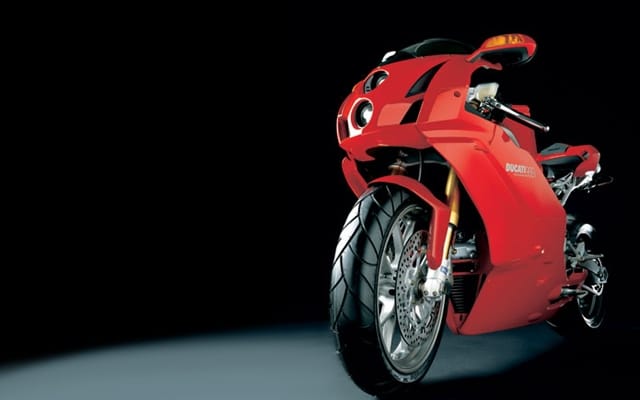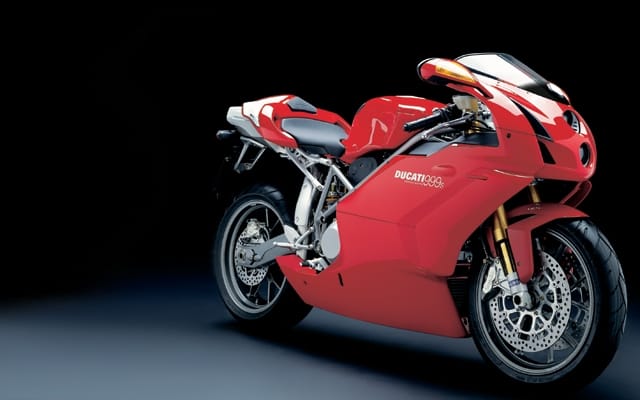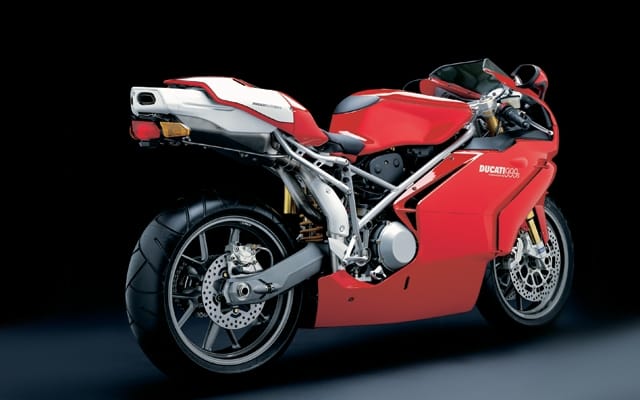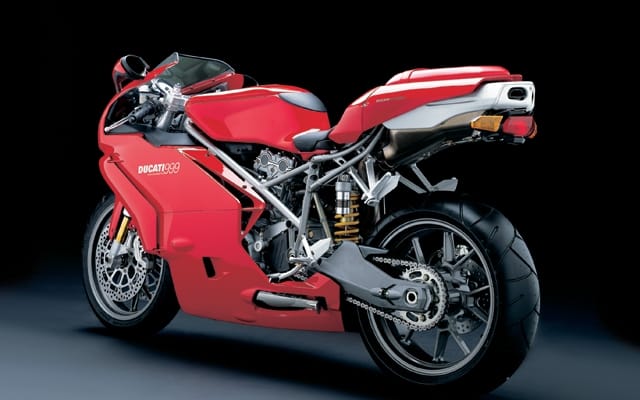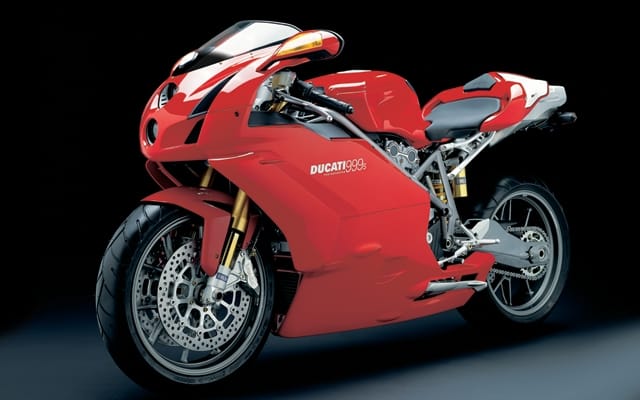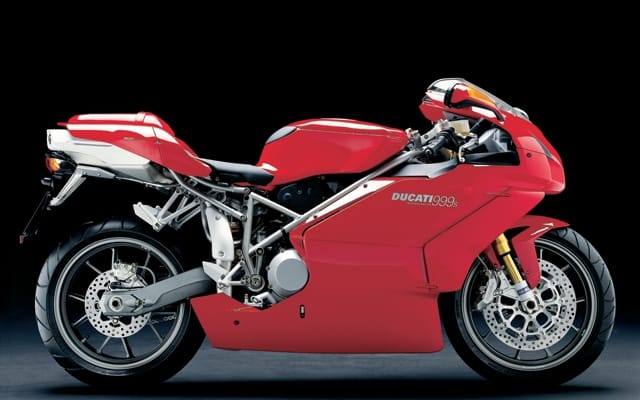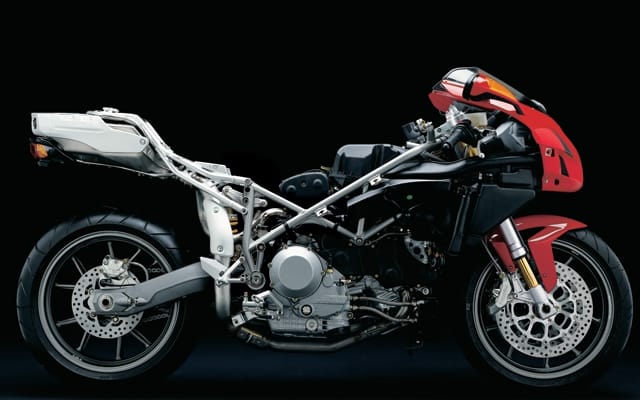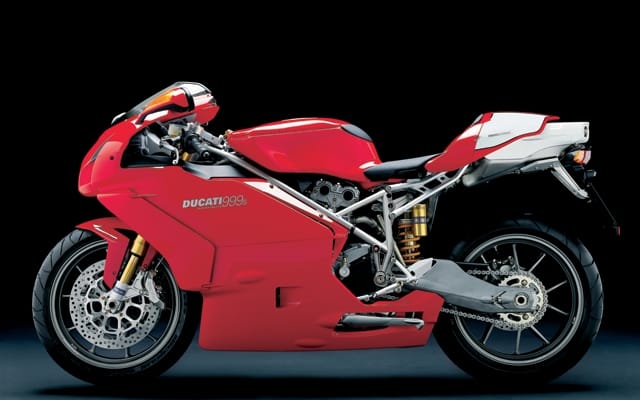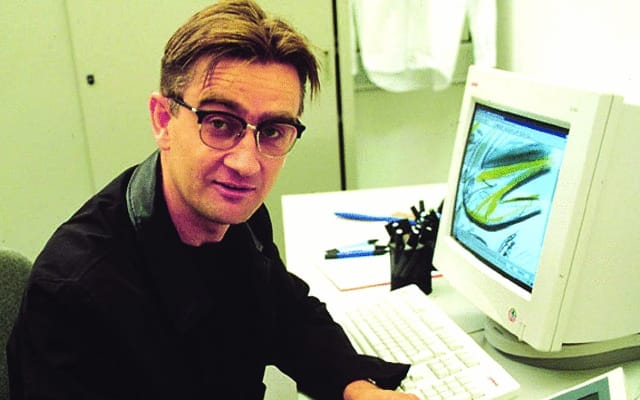When Pierre Terblanche was designing the 999 he said he had “no intention of doing another 916.” Few could have anticipated how prophetic his words would prove. But was the 999 a disaster or was the public too timid to appreciate a masterwork? Sisyphus had it easy. His punishment for defying the gods came after the death he had tried so hard to elude, and if his eternal rock-rolling is still going on, at least it’s taking place in the cosy confines of hell. Out of sight, out of mind.
Pierre Terblanche, on the other hand, still toils among mortals, lesser men who fail to appreciate his genius and who denigrate his achievements. Despite a career full of design successes, his reputation has taken a huge hit since the market failure of Ducati’s 999, the motorcycle that had the unenviable task of replacing the 916, which itself had won the respect of enthusiasts and the dollars of the Ducatisti. But are we being fair? Does the blame for the 999 debacle rightly fall to the man who took on a nearly impossible challenge, or are there other aspects to this story? What really killed the 999?
“They said make it fast, sexy, and red. The rest was up to me,” Terblanche says in Birth of a Legend, the 999 coffee table promotional tome written by Alan Cathcart and Marc Cook and published in 2003 — the year of the 999’s birth and the beginning of a brief and tragic life. Terblanche’s proclamation is seductively short — and totally false. The 999’s design was never completely within the grasp of its designer, and even if it had been, the complexities involved in superseding the 916 required a vastly more detailed design brief if it was to stand a hope in hell of succeeding. Terblanche’s 999 was fast, sexy, and usually red, but design is not the only force that influences a motorcycle’s life. It fell to marketing, engineering, and finance to abandon the 999 after its release, bastardize it two years later, and then finally kill it two years after that. The ultimate indignity came with the launch of a mediocre replacement in the 1098, rushed to market with all the 916’s old styling cues supposedly brought up to date. The market loved it. Who cared if Ducati’s design leadership mantle lay in tatters on the ground? At least they were still in business.
There’s no question that the scope of the challenge was huge, but the 916 is not the only product that’s become iconic, and it’s not the only artefact that’s had its day and come due for replacement. Designers cope with this stuff all the time. Ducati’s 916 is a classic example of old-school Italian design process. Designers are revered in Italy more than in most places, and the 916’s legendary designer Massimo Tamburini was free to sculpt with impunity. Working from the outside in, he reportedly did not hesitate to take an angle grinder to any engine or chassis component that got in his way. By the time Ducati’s engineers got a shot at it there was little to do but stuff all the necessary mechanical and electrical bits in wherever they could. The result is an astoundingly beautiful work of art that is excruciating to ride and a nightmare to work on.
Terblanche’s approach to the design process is different than Tamburini’s. His oeuvre for Ducati demonstrates his form-giving abilities (Supermono, MH900e, Hypermotard) in equal measure to his concern for utility, comfort, and practicality (first generation Multistrada or the sport-touring ST line). The 999 represented for Terblanche an opportunity to apply design to every facet of the motorcycle, without preference or hierarchy. To achieve this, Terblanche reversed the 916’s design process and started from the inside out. Beginning with the rider’s cockpit, he flattened the seat to lessen its forward pitch (to combat the criticism that the 916 jammed the rider’s groin into the fuel tank) and lowered it an inch. Allied with a tapered midsection, this allowed an easier reach to the ground for shorter riders and accentuated the V-twin’s visual distinctiveness over bulkier transverse fours. And to accommodate legs of various lengths, footpegs were made adjustable.
Terblanche’s philosophy found no detail too small, as evidenced by redesigned axle locators that stayed put when the rear wheel was removed, or increased steering lock that allowed U-turns without crushing thumbs between handlebar and fuel tank. With all of this wrapped in gorgeous, rationally derived plastic cladding, there was no reason, in Terblanche’s mind, why a superbike could not also be a super bike.
But upon press unveiling of the 999 in 2002, the howling of complaint was immediate. It wasn’t a 916, and while most seemed to understand that that was precisely the point, the 999 received, at best, cautious approval. Virtually every reviewer hailed the bike for its advances over the 916 in almost every area. More comfort, better performance, improved in every way except one: it didn’t move the soul half as well as it moved the body. Rationally almost perfect for its genre, the 999 was emotionally dead to its audience. Terblanche had single-handedly destroyed a beloved icon, and when the 999 went on sale in 2003, the market’s response was tepid. Somebody would have to pay, and Terblanche got roasted.
Aside from a general antipathy towards anything non-916, critics focussed on three marked departures from the older bike: the swingarm, the exhaust, and the stacked headlights were written off as sacrilegious transgressions, with blame laid squarely on Terblanche. But it’s interesting to ponder what alternative any designer might have had, particularly since Terblanche’s claim at the outset of the project to having total design freedom was clearly not the case.
Most egregious was the loss of the 916’s single-sided swingarm. Sure, other bikes have had them, but the sight of World Superbike pilot Carl Fogarty sliding out of a corner with a touch of opposite lock while fully-flashing a gold-coloured Marchesini magnesium wheel was pure magic. This image of a solitary component became as synonymous with racing victory as the booming note from the V-twin engine. But there was trouble in paradise. Racing boss Claudio Domenicali felt that a slightly longer double-sided swingarm would give race bikes additional stiffness while cutting weight. It’s not clear whether a single-sided swingarm was ever considered beyond the earliest 916-based chassis mules, but the 999’s fat back tire was born cradled in arms on both sides and with the faith that racing success would pull the market onside.
As for the exhaust, Ducati seemed to have forgotten that most basic of motorcycling truths: first you join the tribe by aligning with your chosen brand, and then you differentiate yourself within the tribe by swapping out the exhaust cans for something more personalized. Nothing says “look at me” better than an exclusive motorcycle with a set of expensive aftermarket Termignonis bolted on the back. The 999 didn’t make life simple in that regard, but, again, it’s hard to point the finger at Terblanche. While his integrated, design-touches-everything approach is responsible for the automotive-style single muffler jutting out from under the seat, it was a choice driven by valid reasons. His mandate included taming ever-increasing power in a durable, cost-effective enclosure that now also contained a hot catalytic converter. This was necessary to sell the 999 into markets more heavily regulated than they had been when the 916 was conceived. Problems with heat radiating from the muffler and its plumbing likely had the entire development team wishing Honda had never made their NR750, but there was no turning back from what was now perceived as a Ducati hallmark, albeit merged into a single can. Purists hated it, passengers had reason to hate it more, and the aftermarket largely avoided offering alternatives because the payback on complex tooling wasn’t likely to come unless the bike sold in huge numbers.
Which brings us to the headlights. Early ’90s sportbike lighting typically consisted of a pair of big round lamps close-set into the fairing. Yamaha had groovy cat-eyes, but nothing came close to the aggressive, determined look of the 916’s twin lamps, perched on the leading edge of the fairing, stretched almost full-width, and underscored by a pair of triangulated air intakes. But by the end of the 916’s life everybody had swoopy lights. How do you move product design forward when the equity of past designs is so strong and yet the competition has caught up and passed you? You make a clean break — rationalized by improvements in functionality and buoyed by a visual presence so strong it makes everything else look dated. Terblanche is rumoured to have sought inspiration for the stacked headlights of his 999 in the streamlined locomotives of nearly a century ago. Such romantic notions may have substance, but equally powerful motivation may have come from the need to meet homologation requirements for symmetry about the front view centreline, or in the complex packaging constraints of modern projector headlamps. Whatever the reason, Terblanche might have been wise to follow the creed of one of the pioneers of American industrial design, Raymond Loewy, whose work is particularly relevant to this aspect of the 999’s design. Widely acclaimed as the father of streamlining and author of The Locomotive: Its Aesthetics, Loewy is also remembered for his MAYA principal — Most Advanced Yet Acceptable. He believed that “The adult public’s taste is not necessarily ready to accept the logical solutions to their requirements if the solution implies too vast a departure from what they have been conditioned into accepting as the norm.”
This does not mean that the MAYA-designed artefact needs to be derivative, obvious, or even immediately acceptable; in fact, the opposite is true. Designers know their new design has a market life. Acceptance starts with the approval by early adopters, grows as the product’s market audience catches up with it, and finally wanes as newer, better products learn to compete. A quick comparison with the Japanese competition faced by the 916 in 1994 with the offerings vying with the 999 for market share a decade later shows just how far the industry had come. Strong design statements like stacked headlights and radical exhausts were likely judged necessary if the new bike was going to compete in an increasingly crowded superbike segment full of less expensive and vastly improved Japanese models. Did Terblanche go too far? Was the 999 Too Advanced and therefore Not Acceptable? Perhaps, but Cathcart and Cook include a quotation that suggests Terblanche knew exactly what he was doing, and exactly what had to be done: “I wanted to do something very striking, new, and fresh, that would last until 2010. Something that wouldn’t become dated after three weeks, and so of course you’re going to shock people. I had no intention of doing just another 916.”
Terblanche’s creation, a machine with a planned lifespan of seven years, was revamped after only two. Biannual model revisions may be the norm for larger manufacturers, but they place an incredible financial burden on smaller players and signify big problems. The press material that accompanied the 2005 999 is a fascinating read full of “racing improves the breed” rationalizations intended to draw attention to its successful racing record. The adoption of the 140 hp 999S engine in the base model was done simply to keep pace in a world where outrageously overpowered litre-bikes had replaced the 750 cc fours that had battled the 916. The svelte original swingarm was replaced by a crudely robust version reportedly lifted straight off the race bikes. It remained double-sided. The most obvious revisions were found in a new fairing “aimed primarily at making the production 999 resemble the race machines more closely than ever” at the expense of much of the original design intent. Gone was the aerodynamic drama of the vertically-sectioned fairing, its narrow centre flanked by barge boards, scoops and vents all stacked in a flowing rush that brought air up and over the rider. In its place was a wider, taller, plumper upper fairing with fewer vents flanked by softer barge boards down below. The delicate “zips” were gone and the whole affair tookon a mushier tone that lacked the crisp definition of the original. The stacked headlights and unit exhaust were retained, likely because altering them would have cost a fortune.
Despite racetrack success and the gushing prose of Ducati’s creative department, the market remained unimpressed. Perhaps sensing the same kind of desperation that settles over a bad date, potential buyers saw these changes as proof that Ducati did not have the courage of its own convictions, and the prophecy became self-fulfilling. Then the revised 999 was itself replaced by the 1098 in 2007. Terblanche left Ducati at the end of that year after a decade as head of design, saying he wanted to focus more on design and less on management. The 1098, meanwhile, was well received, built as it was on the respective strengths of the 916 and 999 with a dash of the Desmosedici’s MotoGP allure tossed in. Designed by Gianandrea Fabbro, the 1098 is a successful product that has strengthened Ducati’s coffers. But I suspect Fabbro himself would agree that it isn’t half the design statement of the original 999. The 1098 and its successors are more rehash than retro, comparable to the current spate of newly issued pony cars regurgitated by American manufacturers desperate for niche sales after failing in the majors. Let us hope Ducati’s retreat is temporary.
How else might this story have unfolded? The 1098 offers clues as to changes within Ducati’s product planning, design, and development processes in the years since the shortcomings of the 999 process became apparent. The designer as grand visionary has been replaced by the designer as strategic product planner, as eager to advance visual and kinetic performance envelopes as he is keenly aware of how his new release will be perceived in the context of its predecessor. There appears to be greater communication and a more iterative approach to merging the needs of engineering with the desires of design, as seen in the return of the single-sided swingarm, now somehow able to cope with 50 percent more power than a 916 produced. One wonders how the market might have received the 999 if that small technicality had been resolved 10 years ago.
Finally, Ducati has determined that its superbike is not an “anchor” product — so-called because it doesn’t need to sell so long as it makes the company’s other products look like bargains in comparison. No, this new bike must meet customers’ needs and sell in sufficiently high volumes at reasonable prices: it is a “halo” product, a premium motorcycle at a premium price, but good value, nonetheless. These changes bode well for the financial prospects of the company, and for the incremental satisfaction of the customers it seeks to delight, but I wonder if the risk inherent in the quest for a breakthrough motorcycle as important as the 916 precludes our ever seeing one again.
